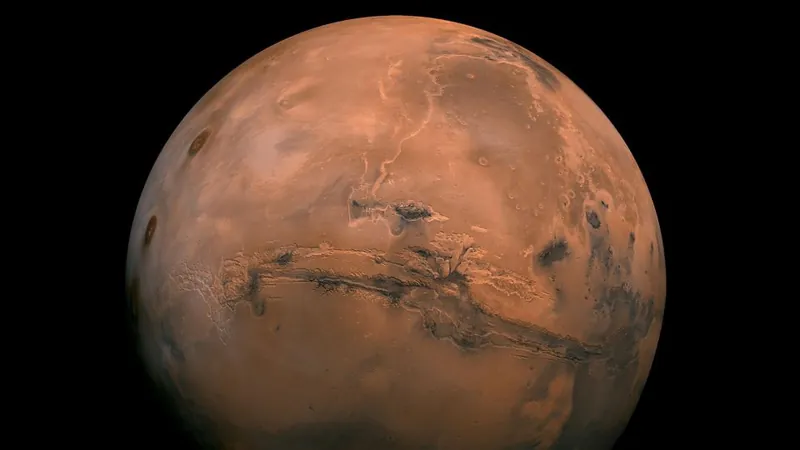
The Hidden Dangers of Mars: Toxic Dust Could Jeopardize Astronaut Health!
2025-03-26
Author: Daniel
Introduction
Recent research has unveiled alarming insights regarding the potential hazards that toxic dust on Mars poses to future astronauts. According to a study published in the journal *GeoHealth*, this dust, which contains harmful substances such as silica, gypsum, perchlorates, and nanophase iron oxides, could severely affect the health of astronauts exploring the red planet.
Impact on Lung Health
The study highlights that one of the most significant threats of Martian dust is its impact on lung health. Due to its ultra-fine particles, the dust can lodge in the lungs and enter the bloodstream, leading to severe pulmonary issues. Justin Wang, a medical student at USC and co-author of the study, warns, "Astronauts already face the risk of pulmonary fibrosis from radiation exposure during spaceflight. The addition of toxins like silica and iron oxides could worsen these conditions."
Perchlorates and Their Risks
Moreover, the presence of perchlorates—chemical compounds discovered in Martian soil at toxic levels—raises the stakes even higher. These compounds can trigger thyroid dysfunction and even aplastic anemia, a serious condition where the body fails to produce enough blood cells. Given the lengthy travel time back to Earth and the communication delays, preventing dust exposure is critical. Researchers suggest implementing dust filtration systems, regular cabin cleaning, and electrostatic devices to repel dust.
Optimism Amid Concerns
Despite these ominous warnings, Wang remains optimistic about Mars missions. "While dust is indeed a concern, with the right preparations, we can mitigate its dangers," he stated confidently.
Global Dust Storms' Effects
Brian Hynek, a geological sciences professor at the University of Boulder and study co-author, points further to the broader implications of Martian dust. "It constantly rains down and covers everything. Major global dust storms periodically cover the surface in a thick layer, rendering spacecraft, solar panels, and other vital equipment less efficient," he explained. In fact, Mars rovers have already faced mission-threatening issues due to dust accumulation on solar panels.
Health Risks vs. Equipment Efficiency
The stakes are high not just for the equipment but for human health as well. Julia Cartwright, an independent research fellow at the University of Leicester’s Institute for Space, emphasized that Martian dust behaves quite differently from terrestrial dust. "On Earth, dust particles are more rounded due to erosion, but Martian dust consists of sharp, jagged particles that can cause serious irritation to human lungs," she highlighted, drawing a parallel to the health risks associated with asbestos exposure.
Contaminants in Breathing Air
In addition to physical health concerns, experts warn about the potential contamination of breathable air with heavy metals like chromium, arsenic, and cadmium. Cartwright advises that even if effective air filters are developed, issues surrounding the maintenance and replacement of these filters need to be addressed, necessitating a stock of replacement filters on missions.
Need for Medical Capabilities
Jonathan Eastwood, a professor of space physics at Imperial College London, concurs that comprehensive medical capabilities will be essential on Mars. "Rapid evacuation back to Earth is not an option, so providing local medical care is vital," he stated. This underscores the need for interdisciplinary collaboration to tackle the multifaceted dangers posed by Mars dust, involving engineering, medical expertise, and scientific research.
Attention from the Space Community
The study has caught the attention of many in the space exploration community, with Natalya Zavina-James from the UK Space Agency noting, "It's crucial to consider the health implications for astronauts as we plan for future crewed missions." She emphasized that these studies are paving the way for future human exploration of Mars, ensuring that health considerations are front and center in mission planning.
Conclusion
As humanity stands on the brink of interplanetary exploration, the challenges posed by Martian dust remind us of the complexities of establishing a human presence beyond Earth. With these findings, it is clear that while the allure of Mars is compelling, the hidden dangers demand our attention and preparedness. What lies beneath the surface could be just as challenging as the journey to get there!



 Brasil (PT)
Brasil (PT)
 Canada (EN)
Canada (EN)
 Chile (ES)
Chile (ES)
 Česko (CS)
Česko (CS)
 대한민국 (KO)
대한민국 (KO)
 España (ES)
España (ES)
 France (FR)
France (FR)
 Hong Kong (EN)
Hong Kong (EN)
 Italia (IT)
Italia (IT)
 日本 (JA)
日本 (JA)
 Magyarország (HU)
Magyarország (HU)
 Norge (NO)
Norge (NO)
 Polska (PL)
Polska (PL)
 Schweiz (DE)
Schweiz (DE)
 Singapore (EN)
Singapore (EN)
 Sverige (SV)
Sverige (SV)
 Suomi (FI)
Suomi (FI)
 Türkiye (TR)
Türkiye (TR)
 الإمارات العربية المتحدة (AR)
الإمارات العربية المتحدة (AR)